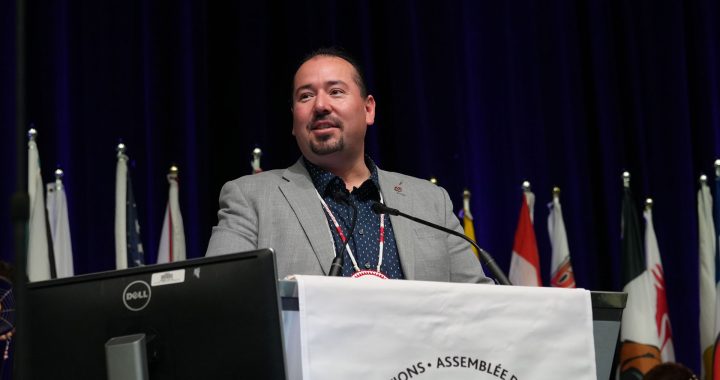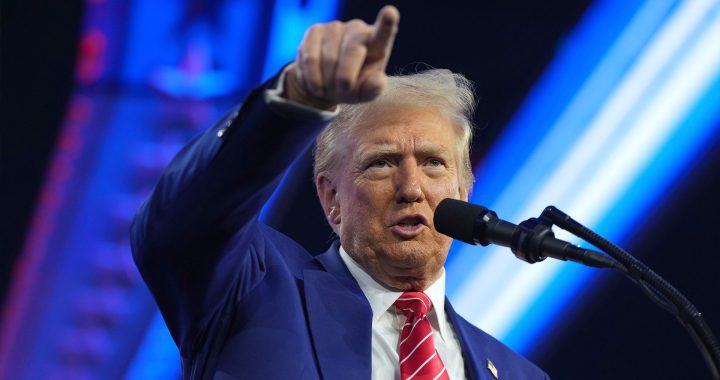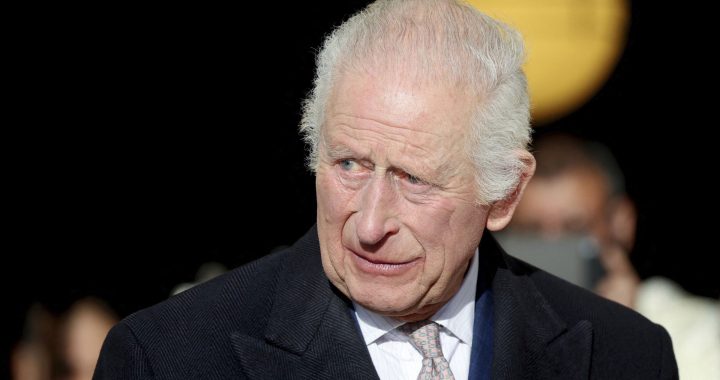
Activists protest against fossil fuels at the COP28 U.N. Climate Summit, Tuesday, Dec. 5, 2023, in Dubai, United Arab Emirates. (AP Photo/Peter Dejong)
Canada’s climate lobby wants its demand for an oil-and-gas emissions cap to go straight to Environment Minister Steven Guilbeault’s head.
Dozens of Canada’s environmental activists are wandering around the event sites at COP28 in Dubai sporting matching baseball hats with the word “emissions” on the front.
The fashion-statement “emissions caps” have become a must-have souvenir of the global climate talks, though only a couple of hundred exist.
The head of Climate Action Network Canada gifted one to Guilbeault in the opening hours of COP28, but she says she told Guilbeault he cannot wear it yet.
Caroline Brouillette says he is only allowed to put it on if he finally publishes the framework for his government’s long-promised cap on greenhouse-gas emissions from the oil-and-gas sector.
She says Guilbeault laughed as he accepted the gift, and told her he would be surprised if he isn’t wearing it before the talks end on Dec. 12.
The Liberals promised two years ago to regulate a maximum limit for emissions from the fossil-fuel sector, but they are months behind in showing where the initial cap will start and where it will have to go down to before the end of the decade.
Guilbeault has been hinting for more than a week that he will show the government’s plan for the cap during COP28.
The ball caps were the brainchild of staff at Montreal’s Trottier Family Foundation, a charity that supports scientific organizations including those that work to combat climate change.
Eric St-Pierre, executive director of the foundation, said in a social-media post that Trottier produced 200 of the emissions caps “for kicks”
Dozens of Canadian activists in Dubai have since taken to social media to show off their caps.
“Emissions cap? In favour,”‘ Canadian Climate Institute president Rick Smith said in a post on X, formerly Twitter. He included a photo of himself and B.C. Environment Minister George Heyman in Dubai, both of them wearing the hats.
Former federal Liberal environment minister Catherine McKenna wore hers Saturday during an event at the Canada pavilion where she called for a windfall tax on oil and gas companies to redirect profits to reducing emissions.
The oil-and-gas industry accounts for more than a quarter of Canada’s total emissions, which amounted to 189 million tonnes of greenhouse gases in 2021.
By 2030, Canada is aiming to reduce total emissions by 40 to 45 per cent compared with 2005 levels.
The emissions reduction plan, the country’s most recent road map intended to help hit that target, suggests oil-and-gas companies must cut their emissions to 110 million tonnes by 2030.
That’s about 35 per cent lower than the industry’s emissions in 2005.
The government said that figure was not set in stone, and the cap may not come in at the same level.
Industry is as eager as environment groups to see the oil-and-gas emissions cap policy, though for different reasons.
The industry does not believe it can cut to 110 million tonnes by 2030 without also cutting production.
Oil and gas have become more efficient, with per-barrel emissions from oil coming out of the oilsands down about 23 per cent since 2009, for example. But increased production means that overall emissions have grown about nine per cent since then.
A year ago, Guilbeault promised draft regulations by the spring and final regulations by the end of the year. But he has since noted that the policy is extremely complex and the federal government is taking time to get right.
Canada is the only major oil-producing country working on an emissions cap, Guilbeault has said.
This fall, the government adjusted its language to promise just a “framework” for the regulations that will identify where the cap will be set and how the regulations will work.
Guilbeault said last week that recent court decisions this fall touching on federal environment policy and jurisdictional limitations had slowed the progress.
Alberta Premier Danielle Smith has said she intends to fight Ottawa’s jurisdiction to impose a cap, though the Supreme Court of Canada’s recent carbon-price decision made clear that Ottawa has some jurisdiction over greenhouse-gas emissions.
The court ruled against Alberta, Saskatchewan and Ontario, which were challenging Ottawa’s authority to enforce a price on carbon emissions in their provinces.










